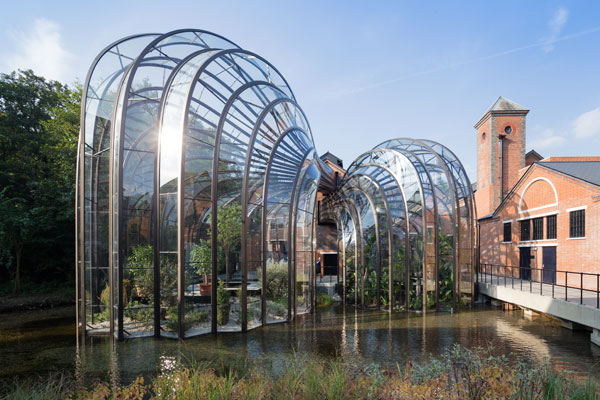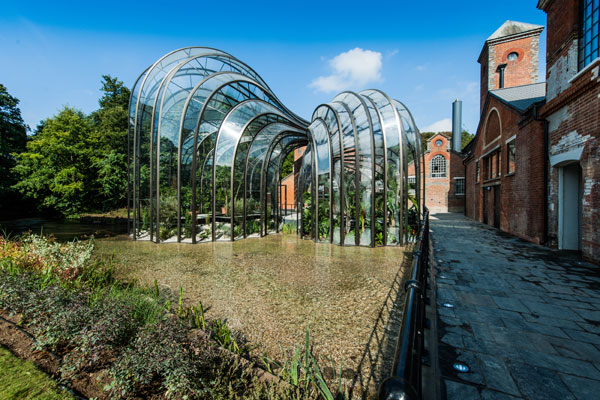Thomas Heatherwick has transformed an 18th century paper mill into the Bombay Sapphire’s first dedicated gin distillery.

November 24th, 2014
Bombay Sapphire, the premium blue-bottled gin, is a drink with serious design connections – it’s ubiquitous at design events around the world, connected with a host of design competitions, and – as of October this year – is distilled in a dedicated facility designed by British designer du jour, Thomas Heatherwick.
The distillery may be new, but the grounds on which it is housed, along with many of the buildings on site, are anything but. The site, located in the village of Laverstoke and straddling the River Test, was originally operated as a corn mill, before being developed as a paper mill in 1718 to produce the world’s bank notes. Over the next two centuries, the mill grew into a sprawling industrial estate comprising over 40 buildings, three of which were Grade II heritage listed.
In 2010, when Bombay Spirits commissioned Heatherwick, the site was a chaotic confusion of buildings, and the River Test was hidden, contained within a narrow concrete channel.
To return the site to its former glory, 23 of the historic buildings were meticulously restored and most of the contemporary industrial structures were removed. “We became very conscious of not wanting to lose a sense of the evolution of the site,” says Project Architect Eliot Postma. “So, wherever a modern dilapidated building leant against an older historic structure, we removed the modern addition but left its mark on the remaining building fabric as a trace of where it had been.”
Yet, it was clear from the outset that clarity wouldn’t be brought to such a disparate site by simply restoring the existing buildings. “From our first visit, it was clear what a beautiful asset the River Test was,” says Postma. “So, a huge part of the focus on the site was opening the river back up, removing the buildings that covered it and re-widening its banks to a more natural setting.
This also gave the water much more visual prominence and allowed the stream to act as a navigational device, drawing the public through the site into the new courtyard at its heart.”
This courtyard is overlooked by the most iconic element of the design – a pair of sculptural botanical glasshouses that seemingly spill out from the main distillation hall into the River Test. The ambitious structures are made from over 10,000 bespoke components, including 893 individually-shaped curved glass pieces held within more than one and quarter kilometres of bronze-finished stainless steel frames.
Inside the Willy Wonka-esque glasshouses – one tropical and the other Mediterranean – grow the ten plant species that go into creating Bombay Sapphire gin, alongside over 100 other supporting species.
“The design for the glasshouses was inspired by historical greenhouses, like the palm house at Kew Gardens or the Crystal Palace,” says Postma. “The opportunity to use the excess heat from the distillation process [to maintain temperatures inside even in the depths of a UK winter] meant that we wanted to connect the glasshouses back to the still buildings. By expressing these links in the architecture itself, it’s almost like the glass is being blown from the still building down to the river below.”
Visitors not only see the botanicals growing, but also witness the vapour distillation process itself, a production technique that stems from a recipe developed in 1761 and makes use of large copper stills.
It’s a welcome change from the banal recreations of production processes and information boards so often found in visitor centres. An upcoming restaurant that utilises ingredients grown on site will only add to the experience.
“We wanted to create a genuine experience,” says Postma. “The core driver for the experience was to allow visitors to experience both the real distillation process, its sights, smell and heat first hand, as well as the real botanicals, the specific plants that are sourced from the four corners of the world.”

It’s this focus on creating an immersive experience for customers – from the visible production process to the clever interactive map – that makes Heatherwick’s vision of the Bombay Sapphire distillery so successful. There is very little back-of-house here. Instead, everything here is on show, in all of its vintage industrial splendour. It’s a fitting home for the design-savvy Bombay Sapphire brand – and, hopefully, a map of sorts for other brands wanting to elevate the visitor experience to production facilities.
Mandi Keighran is Editor-at-large for Indesign, based in London.
Bombay Saphire
bombaysapphire.com
Heatherwick Studio
heatherwick.com
INDESIGN is on instagram
Follow @indesignlive
A searchable and comprehensive guide for specifying leading products and their suppliers
Keep up to date with the latest and greatest from our industry BFF's!

BLANCOCULINA-S II Sensor promotes water efficiency and reduces waste, representing a leap forward in faucet technology.

XTRA celebrates the distinctive and unexpected work of Magis in their Singapore showroom.

In design, the concept of absence is particularly powerful – it’s the abundant potential of deliberate non-presence that amplifies the impact of what is. And it is this realm of sophisticated subtraction that Gaggenau’s Dishwasher 400 Series so generously – and quietly – occupies.
Herman Miller calls in “business doctor” to resuscitate struggling designer furniture dealer Living Edge.

UK based designer Gonçalo Campos turned to his homeland’s major export to realise his latest piece, the Rolha Table
Light gaps are a thing of the past with the introduction of Designed Blinds Australia’s latest innovation – Overlap. Not since the invention of Dual roller blind systems (another original Designed Blinds Australia invention) have roller blinds taken such a leap forward. Our unique bracketing system means that multiple roller blinds can now be linked […]
The internet never sleeps! Here's the stuff you might have missed

In this podcast episode, Timothy Alouani-Roby sat down with Bruce Rowe in Melbourne to talk about his move from professional design practice into the world of art.

Whilst in Australia with Living Edge, Muuto CEO, Anders Cleeman, spoke on the five principles that shape Muuto’s neuroaesthetic approach to product design, and creating humanistic spaces.